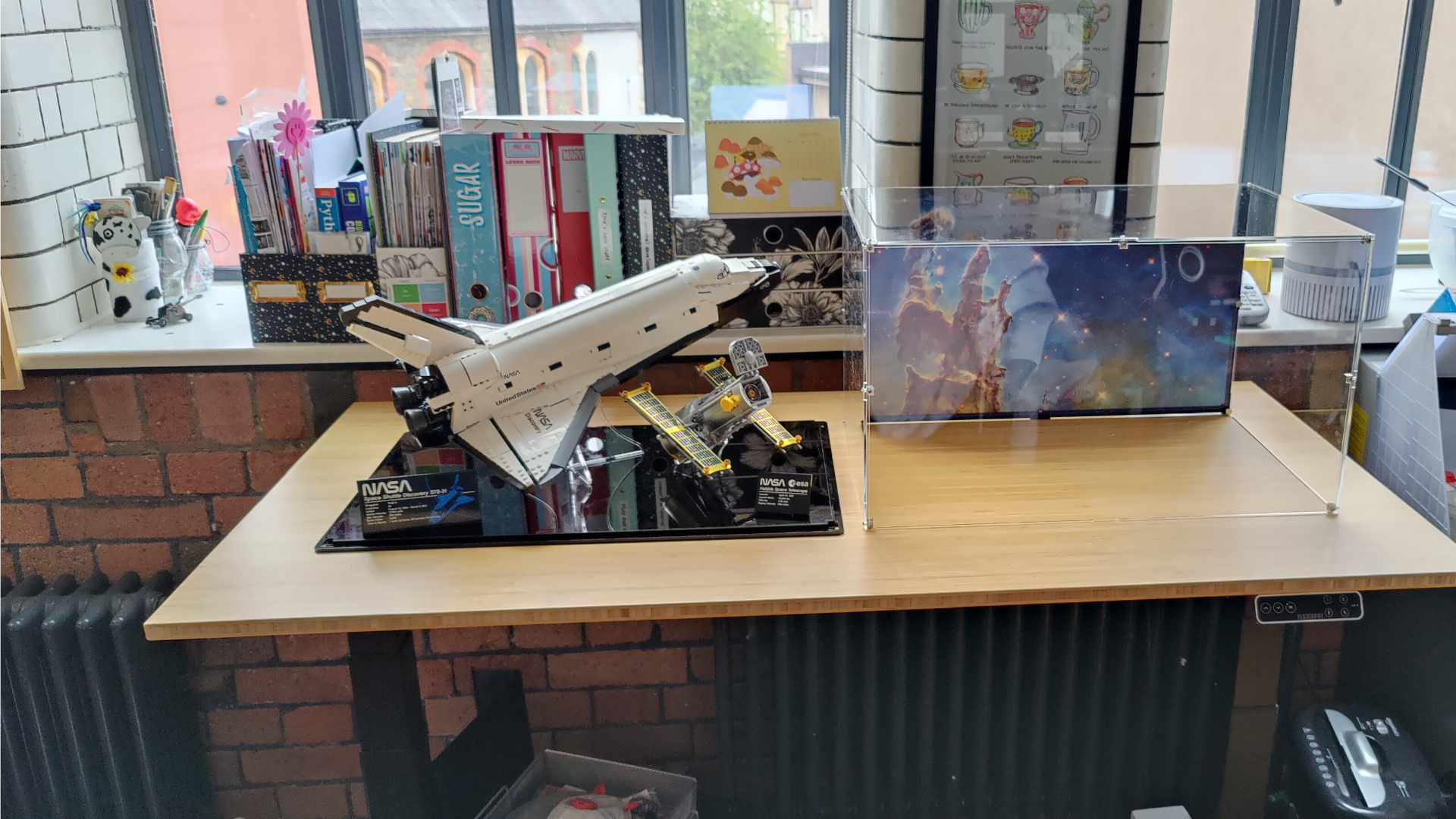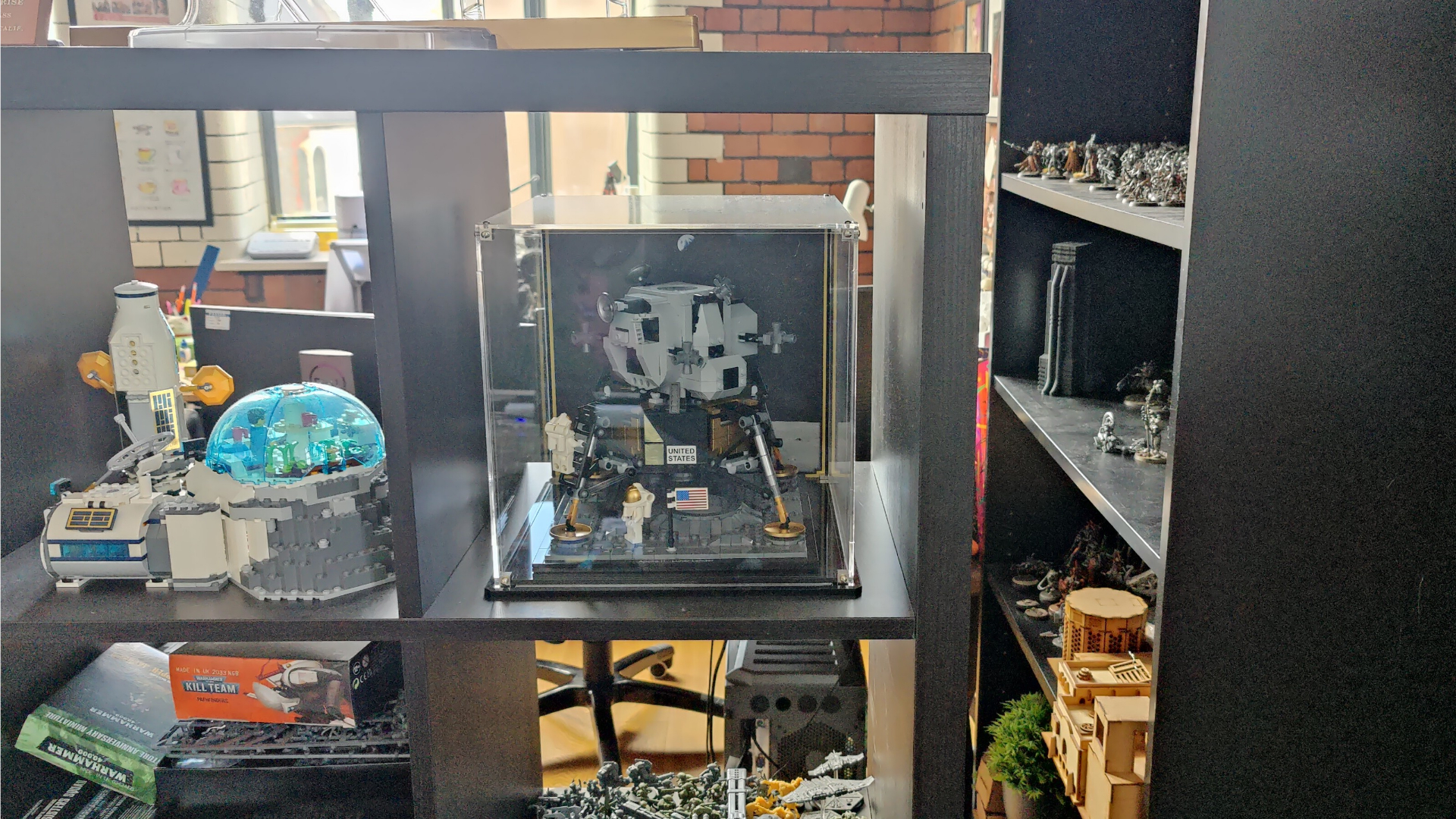Space Verdict
If you want to proudly display your beautiful Lego collection then Wicked Brick offers a fantastic, and relatively unique solution with its custom-made display cases and stands. They're simple to build and look great, even if they are a bit expensive.
Pros
- +
Look great
- +
Easy to assemble
- +
Background images
Cons
- -
Expensive
- -
Fit can be very snug
Why you can trust Space.com
If you’ve got your Lego collection out on display like us, you’ll know that dust is now your mortal enemy. Lego kits accumulate dust at an alarming rate when they’re sat out on a shelf and they can be a real pain to clean - especially some of the more delicate models like the Lego International Space Station.
Fortunately, the good folks over at Wicked Brick have a solution to this problem with their range of bespoke display cases and stands for a huge collection of the Lego range, both past and present. The display cases are a complete acrylic shell to protect your Lego kit, while the display stands are just that - stands that can hold your model in place, either on a shelf or as a wall mount.
Wicked Brick was kind enough to send us out a mixture of cases and stands for us to test with our range of the best Lego space sets so we could put them through their paces, looking at how easy they are to assemble, how well they function and how good they look when they’re on display.
Wicked Brick Lego display cases and stands: head over to Wicked Brick to check out their extensive range of custom display solutions.
Wicked Brick: Build
- Easy to build
- Connections can be tight
We had several cases to put together including full display cases for the Lego Discovery Shuttle, Lego International Space Station, and the Lego Lunar Lander as well as display stands for the Lego Apollo 11 rocket* and Lego ISS.
The cases use a cool system of tiny cubes that form the corner mounting positions to connect the acrylic pieces. This system means that you don't have any unsightly connecting pieces on the exterior corners of the display cases, which keeps the focus on the model being display.
Out of the gate, we noticed that there are no specific instructions for each case - instead there is simply a guide that explains how you do each task. This means you’ll have to figure out how your actual case goes together. It’s not a huge task - the pieces are pretty self explanatory and you’ll quickly figure out which pieces go where, but it’s frustrating that there are no bespoke instructions for each piece.
When you’re assembling the display cases, you start by organizing the pieces and figuring out the layout that you’ll need to assemble it in. We found that starting with the base plate, then building the sides and finally attaching the top was the most sensible order to proceed in. From there, it’s a simple case of removing the protective film from the acrylic pieces - this peels away easily enough.
Breaking space news, the latest updates on rocket launches, skywatching events and more!







If your display case comes with a background image, now is the time to add that in. These are stickers, and anyone who has read our Lego reviews will know that we hate stickers, but these are implemented very well. The acrylic pieces have exact markings to show you where they go, helping you to line things up, and they can be peeled back off if you mess it up, so you can have another go.
To actually build up the case, you use the tiny metal cubes that have screw holes on multiple faces. You line up the holes so they face the correct direction and then screw in the screws to fix them in place. It's quite intuitive, though it can be a little fiddly to hold the cube in place and screw it in.
The only other type of construction that you’ll need to perform is pushing acrylic pieces into slots - this is mainly for the sections that actually hold your model in place (if you’re building a display stand, this is the only part of the construction you’ll need to do). We found some of these connections to be quite snug, and we even managed to snap a piece of our Apollo display stand trying to force it in. In the end, we remembered the old engineering flowchart and added a tiny amount of oil (though we’re sure WD40 would work too) to the remaining pieces and they all slotted in place without any issues.



We’d also recommend that you wear gloves while building the case, or at least when moving it to its display position because they show fingerprints very easily thanks to the mix of clear and gloss black acrylic.
*We were also sent a wall-mounted display stand for the Lego Apollo rocket, but we couldn’t test it without incurring the wrath of our landlords.
Wicked Brick: Design and function
- Display cases and stands look great
- Background images turn models into dioramas
Once they’re assembled, we have to say that we’re blown away by how great all of the Wicked Brick products are, especially the display cases which look fantastic and transition your Lego kits from nice decorations into real centerpieces that you’d be proud to display around your home.
We’re massive fans of the display cases, which look phenomenal when they’re complete with the model inside. The background images are an excellent final touch too, and we’d highly recommend stumping up the extra cash to get one if you’re buying a display case. They provide that final touch that gives each Lego kit that diorama feel. The cases also keep your models dust free, and while they do attract dust themselves, they’re super easy to wipe down.




The display stands aren’t quite as impressive, but they’re also a lot cheaper than the full cases. We think these work best if you already have a large display cabinet and just need a stand to hold the model up. They’re also good for huge models like the Apollo rocket, where you might not have the space for a full display case.




There are also a load of options on Wicked Brick that we didn’t get the chance to explore in this review. There are tiered display stands to help you maximize the visible display place on your shelves, acrylic covers for the ubiquitous Ikea Kallax shelving unit, and loads more.
While we’ve tested a good number of the kits, there are hundreds of cases and stands on Wicked Brick, so if you’ve got a healthy collection of the best Lego Star Wars sets or Lego Marvel sets and need a display case, there is a very good chance Wicked Brick has you covered. Check out the Wicked Brick site to see the full range.
Wicked Brick: Price
Since each product is specific to a particular Lego set, we can’t just give you a simple price rundown but we will run through the cost of all the kits that we were sent and discuss the value proposition.
The display Case for LEGO NASA Space Shuttle Discovery costs $130.29/£120 with a background image, or $108.57/£99.99 without the image. The display case for LEGO Ideas: International Space Station costs $97.72/£89.99 with the printed background, or $86.86/£79.99 without the image - that’s more expensive than the ISS kit itself costs!
Finally on the display case side of things, you can get the smaller display case for LEGO: NASA Apollo 11 Lunar Lander for $54.28 with the background image, or $46.68 without it.






While it’s staggering that the ISS case costs more than the model it’s protecting at first glance, it’s not overly surprising. You pay for display cases based on their size, and the Lego ISS is small in terms of mass, but has a huge footprint so it needs a huge case. You’re also getting a custom built piece that is designed to fit an exact model, which brings the price up too.
The display stands are much cheaper than the cases if you’re looking for something more affordable. The display stand for LEGO Ideas: NASA Apollo Saturn V is $27.14/£24.99 (the wall mounted version costs the same price too).
Overall, we think the Wicked Brick cases are worth the cost, but they’re a niche product for people who can afford to drop this kind of cash on display cases. Luckily, that fits in with the target audience, because Lego collecting itself isn’t cheap.
Should you buy Wicked Brick display solutions?
Ultimately, whether you’re going to be interested in what Wicked Brick has to offer comes down largely to your disposable income, and how much of it you’re willing to spend on Lego and its accoutrements. They offer fantastic display cases and stands that can really bring an extra dimension to some already awesome-looking Lego kits, but they’re not cheap - especially if you’re going for the full display cases.
The display cases look fantastic, especially with the background images and they do a great job of protecting your models from being knocked over, while also keeping them dust free. The display stands are a great cheaper alternative that work especially well if you have an existing display case, like an Ikea Detolf, that you can keep your models inside.
There really isn’t anything else out there that competes with Wicked Brick at the moment, so if you’re a serious Lego collector or just have a few prize pieces that you want to display, then Wicked Brick has exactly what you need.
Wicked Brick Lego display cases and stands: head over to Wicked Brick to check out their extensive range of custom display solutions.

Ian is the Entertainment Editor at Space.com, covering movies, TV series, and games in the space and sci-fi realms. He's a massive sci-fi nerd and has been writing about games and entertainment for over eight years, with articles on sites like Space, LiveScience, GamesRadar, and more. With a degree in biology, a PhD in chemistry, and his previous role at the Institute of Physics Publishing, Ian is taking a world tour through the different scientific disciplines.


